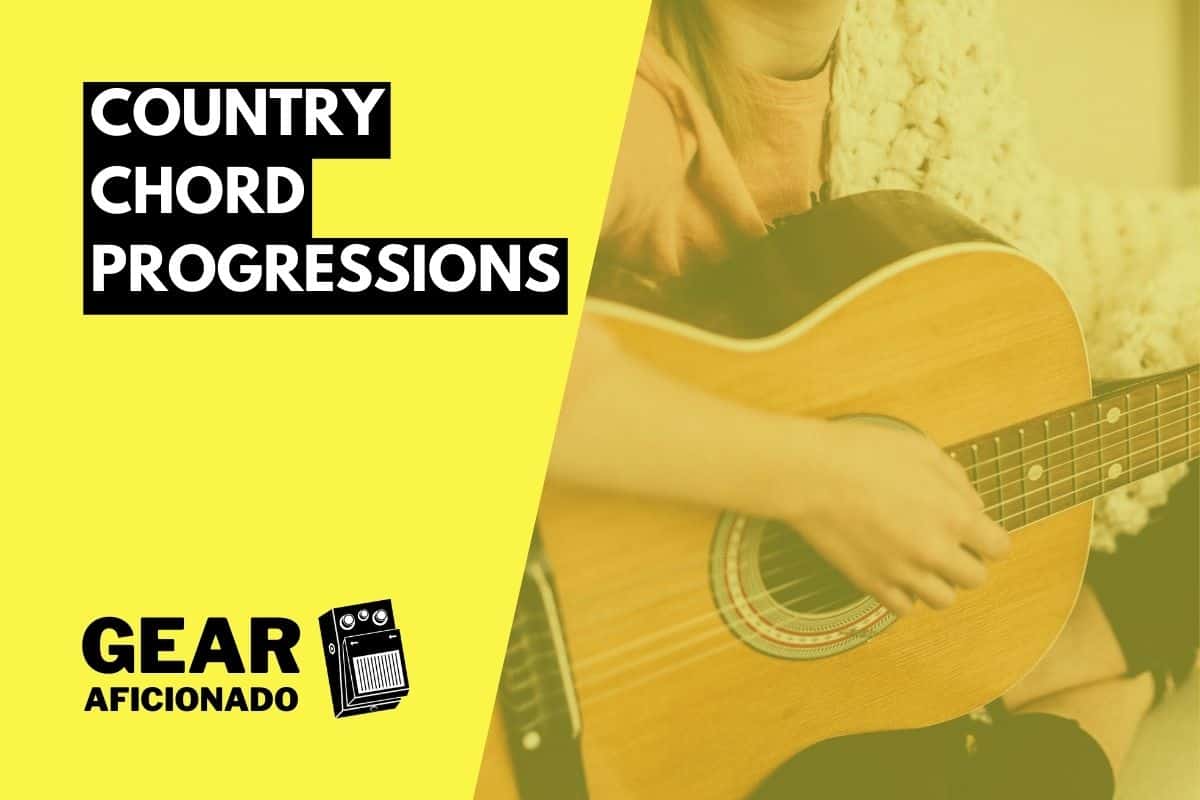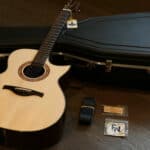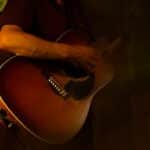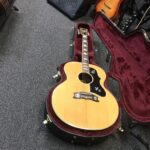Country music has been changing and mutating for the past decades to give birth to a new, arena-ready style that’s slowly taking over the world.
Yes, a long time has gone by since the bonfire and the three acoustics were the rule.
Nowadays, with drums, bass guitar, and a plethora of showbiz resources, country music is ready to take the mainstream like a storm.
But how do you get started with this musical style? Well, the secret, as with many other styles, is to learn the mechanics; what’s happening under the hood.
That’s exactly what we’re here to do: dissect the tone and chord progressions that make country music irresistible for a growing number of people around the world.
Put on the hat and clean the boots because we’re about to rodeo!
Let’s Talk Country Tone
There’s one thing that defines country tone: twang.
Yes, the country music world was forever changed at the beginning of the 1950s when Leo Fender and his fellow companions gave the world the ultimate country machine: the Telecaster.
Before that, and until these days, though, much of country music was and still is in the folk-friendly acoustic edge of guitar playing.
Yes, the very origins of the style are still as alive as ever with all-acoustic bands performing everywhere in the country.
Furthermore, the biggest brands in the world are reissuing banjos and fiddles to keep the legacy alive.
Let’s talk about the essential instruments to play country music.
Acoustic or Electric?
The first decision you need to make when you’re setting sail toward country territory is if you’re going electric or acoustic.
These are two very different approaches and the tone pursuit on each side of the spectrum is very different.
On one hand, acoustic playing is mostly about thumb alternating and “cowboy chords” (which are, essentially, open chords).
You can think of players like Johnny Cash, Chet Atkins, and Bryan Sutton who have mastered the style on the acoustic.
Moreover, if you (like most people) think of country music and close your eyes, you’ll think of a deep voice, lyrics about life in the countryside as well as a broken heart, and a steel-string acoustic guitar.
On the other hand, electric players tend to develop the fast-fingerpicking technique known as chicken picking oozing twang, and making the dance floor raise the temperature.
This very fast, banjo-like picking technique matched with some fast fingers on your fretting hand can drive a crowd wild.
So, this is your first decision: are you going for the singer-songwriter with a hat and soulful lyrics, or do you want to rip the stage with your playing?
The Telecaster is Queen
If you decide to go electric, the Telecaster is the absolute queen of country music.
Just as much as Stratocasters rule the blues and Les Pauls dominate hard rock, Telecasters own country music.
You can see countless country legends holding a Telecaster.
From Australian-born country star, Keith Urban to the amazing Brad Paisley, all the way to guitar masters Danny Gatton and Vince Gill, they have all made their way in music holding a Telecaster (or a legion of them).
So, we can say that, while country tone is defined by the Telecaster, the Telecaster is also defined by country tone.
The moment you play something on your instrument picking close to the bridge, the twang appears, and you’re suddenly in country territory.
It’s not because the guitar was designed for country music, but because you’ve heard it on so many recordings, they are completely inseparable.
So, if you’re going to go electric on your country approach, try first with a Telecaster.
PRO TIP: Although most rock and blues players shy away from maple necks, country music guitar tone has maple neck written all over.
Yes, you need that fast attack, crystal-clear highs, snap, and, of course, the twang on steroids maple can give you.
Also, ash and pine bodies will enhance that mid-high frequency boost the guitar naturally has.
The Dreadnought is King
Talking about tone, we need to talk about the acoustic guitar that can help you rule the country music scene with your groundbreaking tunes.
Well, the acoustic guitar shape you should be looking at to play your way to stardom effortlessly is dreadnought.
This guitar shape was invented by Martin in 1916.
At that moment, it was the biggest, loudest, best-sounding, most resonant guitar in the market.
Because of those characteristics and because of its square shoulders and top-notch construction, the dreadnought took over the market and is still today the most common shape you’ll find when shopping for an acoustic guitar.
But why should you buy a dreadnought?
Well, there’s something about the mahogany back and sides that gives a guitar that size a nice growl to back up your thumb action while the Sitka spruce top brings in the snap and high frequencies you need for the fingerpicking parts.
A great example of a country icon playing a Martin D-14 throughout his career was Johnny Cash.
Thus, the brand celebrated the late star a short time ago with a commemorative model.
If you’re going acoustic, you have to go dreadnought.
Some Amps That Rock The Country Scene
It’s great if you can get yourself a Telecaster to pursue your country music dreams with, but where are you plugging it? Well, let me give you some advice about this:
- Fender Deluxe Reverb Amp – Perhaps, the best option in the market today is the reissue of the ’65 Fender Deluxe Reverb Amp. This is a 22-watt amplifier with a single 12” speaker that you can use at breakup volume mostly anywhere while enjoying the tube-driven reverb and tremolo circuits. If you can afford it, nothing sounds twangier than one of these and a Tele.
- Fender Princeton Reverb Amp – If you need to shrink the size and maintain the tone, swapping the Deluxe Reverb for a smaller Princeton Reverb will give you the same tone in a smaller package. The 10” might be a deal breaker for some, but you can always plug it into an external 1×12” cabinet.
- Fender Twin Reverb Amp – If, on the contrary, you need to upscale your rig to play at bigger venues, then you need to get a Twin Reverb Amp that has the same tone but with 2×12” speakers and 80 watts of pure valve power. An instant classic.
- Fender Bassman ’59 Reissue – For those who find the Fender amps described above as a little too bright, the Bassman can be the perfect remedy. You still get the snap and twang, but your low-end will become bigger and more present. Plus, it’s a 4×10 combo, which enhances your guitar’s low-end and midrange naturally.
- Fender Blues Deluxe – For those who don’t have the budget to go for the American reissue line Fender offers, the Fender Blues Deluxe is a great option. Its dark tone and superb reverb circuitry will give you lots of Fender-approved joy.
- Fender Blues Jr. – If you want to scale down budget, power, and size but maintain tone and attitude, the Blues Jr. is the perfect option. It’s small, reliable, portable, and powerful enough for a stage with a Shure SM57 in front of it.
The combination of Fender with Fender is what country music needs to sound at its best.
Another great recommendation is the Strymon Flint pedal, which can fenderize any amp (especially recommended to go with the ’59 Bassman).
15 Country Chord Progressions
1. I – bIIdim7 – ii7 – IV
2. I – I – IV – IV – V – (V – V7) – I – I
3. I – V6 – vi – I6/4 – IV – IV – V – V
4. I (8x) – IV (4x) – I (4x) – (V7 – ii) – V7 (3x) – I – I
5. I – vi – V – IV
6. I – III7 – (IVmaj7 – vii – I) – (IV – VIIdim – vi) – (Imaj7 – I7) – (VI – VI7) – (II – II7) – V7
7. I – I – IV – IV – V – V – I – I
8. I – V6 – (vi – I6/4) – (IV – V7)
9. I – V – vi – IV
10. (I – VII) – VI7 – (ii – iimaj7) – ii7 – V7 – V7 – (I – bIIdim) – (ii7 – V7 – Vaug7)
11. I – iii – IV – I – I – iii – IV – V
12. I – IV – V
13. I (4x) – IV (2x) – I – (I – IV) – I (3x) – (I – vi – V) – IV – V7 – (I – IV) – I
14. I – IV – I – V
15. I – I – ii – ii – V7 – V7 – I – (I – V7)
The Bottom End
With these 15 quintessential chord progressions, you can play a vast catalog of country tunes.
Moreover, if you follow our tone tips, you might even get to sound just like your favorite records.
Yet, what matters the most is that you get lost in this musical universe and come out the other way with a handful of new songs to give the world.
Believe me, there are few things as inspiring on this planet as plugging your tele straight into a Deluxe Reverb and letting that maple neck rip the fabric of reality into two.
Happy (country) playing!

Hello there, my name is Ramiro and I’ve been playing guitar for almost 20 years. I’m obsessed with everything gear-related and I thought it might be worth sharing it. From guitars, pedals, amps, and synths to studio gear and production tips, I hope you find what I post here useful, and I’ll try my best to keep it entertaining also.





